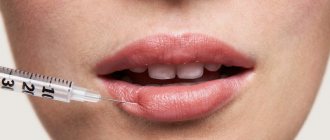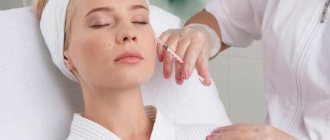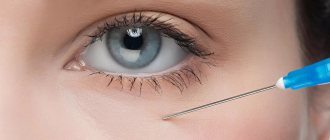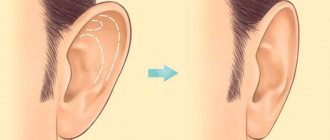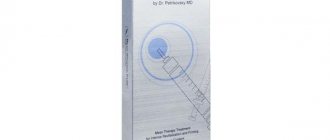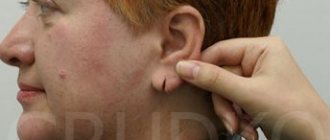Interview with Mikhail Savelyev, Candidate of Medical Sciences.
Hello, friends!
I think each of you can remember a lot of funny films, cartoons or just cartoons, where the main character was a character with funny protruding ears. Or, even funnier, with one protruding ear. When you look at such a “face,” you involuntarily want to smile. And this character seemed a little stupid and defenseless. And as a child, I always wanted to either pull the protruding ear or click on it... It’s funny, isn’t it? And the sound is funny... Well, how many funny and not so funny, and even, at times, evil and offensive nicknames have we come up with for our classmates, playmates in the yard, or just casual acquaintances? After all, it's fun! And how many “elephants”, “monkeys”, “Chit”, “Zhakon”, etc. walked and walk among us. and so on.
But few people saw the bitter tears of these unfortunates, which they shed alone, cursing their fate, nature, parents, and cheerful scoffers. Such chronic psychological breakdowns, a feeling of dissatisfaction with oneself, a feeling of inferiority that does not depend on you and which you are unable to correct is the most direct path to the formation of a depressive state, which gradually leads to deep psychological complexes that affect the rest of your life. Ask anyone, I’m sure any adult with protruding ears - would he like to have “normal” ears from birth? I think you know the answer yourself.
What are the causes of protruding ears?
There is no consensus among experts on this issue. Some consider it a consequence of incorrect intrauterine presentation of the fetus, others are convinced of the purely hereditary origin of this feature of the development of the auricles. Moreover, often in one family there are several generations of relatives with protruding ears.
Be that as it may, the essence of the problem is the excessive growth of the cartilage tissue of the auricle or the formation of an incorrect angle of its contact with the surface of the head. Many parents do not attach importance to this feature of their child’s appearance and take it for granted.
However, in recent years, with the development and increasing availability of plastic medicine for an increasingly wider population, the problem of protruding ears ceases to be “fatal”; a huge number of clinics, medical centers of different price and professional levels undertake to “easily” eliminate a “small cosmetic defect”. An operation called otoplasty is offered.
Its essence lies in the fact that a plastic surgeon, under local or, more often, general anesthesia, dissects the skin behind the auricle, then, removing excess tissue, models a new shape (angle of contact) of the cartilage. After this, the cartilage is sutured and the incision is closed with a cosmetic suture. The operation is completed by placing special rollers and applying a special bandage or pressure bandage, which must be worn for at least one month. It would seem that everything is simple. But let's take a more balanced look.
Any surgeon will tell you in a frank conversation that absolutely any method of anesthesia is a potential risk. And with general anesthesia, the risk increases exponentially. In fact, if we put aside purely commercial interests, plastic surgery should be performed only according to strict indications. For example, unacceptable facial disfigurement, tight scars, the need for skin grafts after deep extensive burns, the inability to breathe normally, eat or use limbs. An indication is also a severe depressive state of the patient, directly caused by one or another cosmetic defect, in which a long course of psychological and psychiatric treatment does not produce tangible results.
In all other cases, the doctor follows the lead of patients treated by continuous and intrusive advertising, who cannot resist the powerful fashion industry that cultivates stereotyped images. And money in this case is everything.
Why, in my opinion, you should refrain from otoplasty:
- During the operation, the cartilage tissue is dissected and excised, inevitable hematomas are formed, which can take up to six months or longer to resolve, can fester, organize into connective tissue, in turn, deforming and disfiguring the auricles.
- With insufficient qualifications of medical personnel, violation of the rules of asepsis and antisepsis, the occurrence of a so-called “wound infection” is very likely, which will require repeated surgical intervention and powerful antibiotic therapy.
- Sometimes, after the intervention, the ear cartilages acquire unevenness and corrosion, the likes of which can sometimes be seen in professional wrestlers or boxers. Elimination of such complications is a much more complex, time-consuming and expensive procedure.
- I will not dwell in detail on the possible serious and sometimes fatal complications of general or local anesthesia. Starting from anaphylactic shock, heart failure, laryngo- or bronchospasm and many, many others.
- Not the least important consideration when deciding whether to undergo otoplasty is the cost of the operation. On average in St. Petersburg, such an operation, excluding the costs of preliminary examination and subsequent rehabilitation, is about 32-40 thousand rubles, depending on the class of doctors, location of the clinic, brand promotion, etc. In this case, we keep in mind the likelihood of re-application.
- Correction of protruding ears. Non-surgical method.
Most plastic surgeons recommend otoplasty for children aged 6-7 years, arguing that it is at school that the child runs the risk of falling under a barrage of ridicule and bullying from his friends. At the same time, the fact that the formation of a child’s auricle, as a rule, is completed by the age of nine, is “delicately” omitted. Thus, the lesser evil that we can get is the return of the ears to their original (pre-surgery) position. In this case, repeated, and often more than one, operation is necessary.
An innovative development called “silicone otocorrectors” has become a real salvation for many parents concerned about the future physical and emotional health of their children, and for many tens of thousands of adults who have deeply driven childhood resentment and shyness into their souls, or are hiding behind ostentatious aggressiveness or indifference. The essence of the development is extremely simple, like everything ingenious. Pairs of small (size 1.8x1 cm for adults) kidney-shaped plates are made from transparent hypoallergenic silicone. A special hypoallergenic glue is applied to them in a thin (0.3 mm) layer, which has high adhesive properties to both silicone and human skin. Both silicone and glue are absolutely safe for humans, they have passed multi-stage tests and have the necessary certificates. All that remains is to stick one thin transparent plate on the scalp, and the other on the back surface of the ear. After this, with light pressure, the plates are connected and give the auricle an aesthetically acceptable position. Needless to say, what relief thousands of people who now use our otocorrectors receive, feeling like full-fledged, beautiful and successful people and without exposing themselves to the often unjustified risk of operations, possible complications associated with them, significant and often unpredictably high material costs.
The average retention period for silicone otocorrectors is up to 7 days. Of course, the characteristics of the user’s skin matter, as well as strict adherence to the instructions for using otocorrectors, which are included with each set.
Doctor's opinion Certificates Wholesale Official website
If you have any questions, please contact:
Toll-free hotline number: 8 800 707 16 97
Messengers: 8-952-411-37-58
✉
✉
• The adhesive layer has been damaged
— Before you begin the procedure of gluing the corrector to the skin, make sure that the work area is sufficiently prepared. It is recommended to shave the hair located at the site of attachment of the otocorrector. This procedure should be repeated periodically, as hair can disrupt the adhesion of surfaces. It is recommended to remove long hair. securing them with hairpins or clips. If necessary, reapply glue.
• Insufficiently degreased and/or moist skin
Insufficient exposure after treating the skin with a degreasing composition. In this case, the evaporating solution will prevent reliable fixation of the otocorrector. The ear correctors were attached in a room with high temperature or humidity (bathroom, swimming pool, gym, etc.). Wet leather leads to a weak connection between the leather surface and the adhesive layer, even after several treatments of the leather with a degreasing solution. The presence of maceration of the skin after excessively intensive treatment with a degreasing composition or after removal of the otocorrector. You should refrain from using ear correctors until signs of skin irritation disappear. If you are unable to attach the otocorrector yourself, ask someone close to you to help you.
Doctor's opinion Certificates Wholesale Official website
If you have any questions, please contact:
Toll-free hotline number: 8 800 707 16 97
Messengers: 8-952-411-37-58
✉
✉
Time to change
Doctor's opinion Certificates Wholesale Official website
If you have any questions, please contact:
Toll-free hotline number: 8 800 707 16 97
Messengers: 8-952-411-37-58
✉
What causes protruding ears?
Excessively protruding ears are not considered a pathology. If they are present, hearing is not impaired and no diseases occur.
This feature affects the psychological state of the flop-eared person: he is burdened by aesthetic insufficiency, believing that those around him, seeing the defect, mock him. The female gender is especially concerned about this.
It is possible to become the owner of highly reflexed ears:
- having received an inheritance from their ancestors;
- “earning” in infancy during sleep (sleeping babies bend their ears when they turn over) or under an incorrectly put on cap;
- providing yourself with a flaw due to injury.
Those who have protruding ears may be interested to know that in Japan, protruding ears are a sign of intelligence and luck.
Droopy ears and causes neuro-psychological instability of the formation of personality.
Hello friends! I think each of you can remember a lot of funny movies, cartoons or just cartoons where the main character was the character with funny protruding ears. Or, even funnier, one protruding ear. When you look at this “face” involuntarily want to smile. And this character seemed a bit silly and helpless.
And as a child wanted, or to pull protruding ear, either click on it... pretty fun, right? And sound ridiculous... Well, how old and not very funny, and even, at times, angry and insulting nicknames we have come up with their classmates, playmates in the yard, or just casual acquaintances? It's fun!
And how many walked and walks among us, “elephants”, “monkeys”, “Cheat”, “Jakon” and etc., etc.
But few have seen the bitter tears of these unfortunates, which they shed in solitude, cursing my fate, nature, parents, and a wide, mocking eyes.
Such chronic psychological damages, a sense of dissatisfaction, a feeling of inferiority, which does not depend on you and that you are not able to fix the most direct path to the formation of the doldrums, gradually leads to deep psychological complexes that affect their lives .
Ask anyone, I'm sure any adult with droopy ears — if he wanted to since birth he had “normal” ears? I think you know the answer yourself.
Ways to get rid of protruding ears
Not everyone has the opportunity to live in the Land of the Rising Sun. But they have a chance to free themselves from annoying imperfection in 3 ways.
- Use ear correctors starting from infancy. Cartilage is endowed with plasticity for about six months to a year, then turns into a dense state. During this period it is possible to give the desired shape to the shells. To do this, the accessory must be worn for a long time.
- Use endoprosthetics. The procedure involves installing an implant under the skin. A special device will give the required shape to the auricle. However, such manipulation is difficult to perform.
- Apply for otoplasty - an operation that can change the angle at which the auricle joins the skull. It is permissible to apply for the test from the age of 6 years.
The surgical intervention is performed on the patient under anesthesia and who has no contraindications to the procedure.
What are the causes of prominent ears?
Among experts there is no common view on this issue. Some consider it the result of improper fetal presentation of the fetus, others believe in a purely genetic origin of the peculiarities of the development of the auricles. Moreover, often in one family there are several generations of relatives with droopy ears.
Anyway, the essence of the problem of excessive growth of the cartilage of the auricle or forming a wrong angle of its contact with the surface of the head. Many parents do not attach importance to such features of the appearance of their child and accept it as “reality.”
However, in recent years, with the development and increasing availability of plastic medicine to a wider population, the problem of prominent ears ceases to be a “fatal” a huge number of clinics, health centers at different price and professional level are “easy” to fix “minor cosmetic defect”.
Offers a procedure called “otoplasty”.
Its essence lies in the fact that a plastic surgeon under local or more commonly General anesthesia is conducting the dissection of the skin behind the ear, then removing excess tissue, models the new shape (angles) of the cartilage. After that the cartilage is sutured closed and the incision cosmetic suture. The operation is completed with a summary of the special rollers and apply a special bandage or pressure bandage to wear which account for not less than one month. It would seem that everything is simple.
But let's look more balanced.
Any surgeon in a Frank conversation I will tell you that any method of anesthesia is a potential risk. While under General anesthesia, the risk increases exponentially. In fact, if we ignore the purely commercial interest, plastic surgery should be conducted only under strict indications. For example, unacceptable disfigurement of the face tightening scars, the need for skin grafting after extensive deep burns, the disability normal breathing, eating, or use of limbs. Also the indication is severe depressive state of the patient, directly arising from those or other cosmetic defect, which a long course of psychological and psychiatric treatment does not produce tangible results.
In all other cases, the doctor goes on about processed continuous and hype patients who are unable to resist the powerful fashion industry, cultivating stereotyped images. And money in this case are everything.
✉
✉
What do ear correctors look like and how do they work?
Products are available in many varieties. However, they all have a simple and similar design.
A separate accessory consists of 2 transparent silicone fragments, fastened together and invisible to prying eyes.
All brands of products work the same. Minor differences include more convenient fastening and wearing comfort.
Using a hypoallergenic special product, a separate corrector is glued to the skin of the ear on one side and to the head on the other. Designed to give the ear an aesthetic appearance, the accessory presses the auricle to the temples for a long time, giving it the desired shape.
Over time, the cartilage of the auditory organ adapts to this position and acquires the desired appearance, as a result of which wearing a corrector is no longer required.
True, the expected result comes after 6-12 months. According to other manufacturers, with their products the effect is acquired within a month. However, there is no evidence for such advertising.
Experts have a different opinion. No corrector model provides a 100% guarantee. It's all about the structure of the auricle and the predisposition of the cartilage to respond to changes.
Some representatives of lop-eared people do not like silicone, although it is hypoallergenic, due to the occurrence of unpleasant sensations in the form of skin irritation.
And this forces those with protruding ears to remove the accessory faster than the designated period. In such a situation, it is problematic to expect results.
Correction of the shape of the ears can be started at any age, but the effectiveness will vary.
Device device
Mairs' solution to breathing problems comes in the form of a small clip that is inserted into the nose before bed. Neodymium magnets are located inside the spherical ends. Externally, the corrector looks like a nose clip that swimmers use. They just use it differently.
The manufacturer claims that the clip can relieve snoring due to the influence of magnets. Magnetic field waves help saturate the blood with oxygen. This normalizes breathing. In addition, the muscles of the nasopharynx and soft palate are stimulated, which opens the airways.
The design of the corrector is very comfortable: the clip is almost not felt in the nose and, at the same time, is tightly attached. It does not fall off during sleep, which ensures quality rest and complete free breathing.
How to use? (3 important rules)
Using ear correctors is quite simple, but you still need to adhere to a certain algorithm. Ignoring the rules will inevitably lead to damage to the product and a reduction in wearing time.
- Before installing the accessory, the skin in the ear area must be degreased using a lotion designed to remove fat. After this, you should wait for the surface of the epidermis to dry completely.
- The protective film is removed from the adhesive side of the corrector so that the fingers of the person installing the accessory do not come into contact with them.
- One fragment of the product is attached to the upper border of the auricle, the second - to the area of the head behind the ear. It is necessary to ensure that the attachment of the 2 fragments takes place while maintaining their parallelism relative to each other and without getting hairs or any foreign particles between the skin of the ear and the plate.
The product placed on the ear is worn continuously for 5-10 days. After this time, it is removed and thrown away. The previous accessory is not suitable for reuse, but it is not forbidden to attach a new one (1 or 2 at the same time).
Sometimes the specified period of wearing the corrector is not maintained. This happens when the person using the pad washes his hair, bathes in the bathtub and other bodies of water, or goes to the bathhouse/sauna. The above reasons often provoke the product to peel off.
Sometimes the pad used to correct protruding ears breaks. This indicates poor quality manufacturing of the product. Peeling occurs before the specified wearing period and if the accessory is attached to wet skin.
It happens that there is a need to remove an accessory. To carry out the manipulation, you will need a cotton swab soaked in moisturizing cream or oil.
One of the attached edges of the product is raised, a disk of cotton wool is inserted into the gap between the plate and the skin until they are separated.
If irritating symptoms occur, it is better to consult a dermatologist.
Contraindications for use
In fact, there is only one contraindication to the use of an accessory for the treatment of protruding ears - this is an allergic reaction to silicone and glue with individual intolerance to the material of manufacture and the means for gluing.
An allergy also occurs at the point of contact of the accessory with the skin, with increased sensitivity of the epidermis of a person with protruding ears.
A dermatologist will help you understand the problem, otherwise correction of the hearing organs will harm such a patient.
Those who have damage, open wounds, or cuts at the place where the accessory is attached should not temporarily use the corrector. But after healing the gluing zone, it is not forbidden to use the product.
If the plates are not attached correctly, folds in the skin sometimes form. They often become inflamed and even bleed.
We must wait for the problem area to recover and return to the possibility of correcting protruding ears with the help of correctors.
Efficiency
The effect of the corrector on the ear cartilage allows you to correct protruding ears. But in childhood it is easier to achieve the desired result. This is due to the fact that the blood of a half- and even one-year-old child contains maternal estrogen hormones.
They provide cartilage with softness, elasticity and pliability. And if the cartilage tissues are fixed in the desired position for a long time during this period, the ears, due to the acquired compaction, may remain in the resulting position.
But you will have to wait 6-12 months for a lasting effect, provided that you continuously use the anti-protruding ear accessory.
In adolescents and adults, cartilage acquires sufficient density, but loses elasticity. Because of this, the period of use of the ear accessory for correction becomes longer, up to 2 years or more.
But even an extended period sometimes gives an insignificant effect, and in frequent cases there is no result at all.
One small but very important detail
Custom earmolds, or IEMs, are an important part of behind-the-ear hearing aids. The comfort of a hearing-impaired person depends on their quality and condition.
There are standard and individual IPMs (more details here). The latter, of course, are better because they are selected, or rather manufactured, for a specific person, taking into account all the anatomical features of his ear canal.
It is not difficult to care for them, but routine actions must be performed daily, and once at an interval determined by a specialist, they must undergo a “technical inspection.”
Which ones should you prefer?
Among buyers, the brands of ear correctors “Arilis” and “Otostik” are especially in demand.
Features of Arilis
In Russia it produces products with the following advantages:
- made from durable and glassy silicone - a material that allows accessories to be invisible on the ears;
- hypoallergenicity of the materials used - they are marked with a medical certificate;
- non-standard technique of applying glue - the adhesive substance allows the loose ear corrector to be held in place if the accessory is simply pressed against the skin. It will remain in the glued place even if water penetrates under it;
- the resulting shape of the auricle remains for up to 7 - 10 days and with an energetic rhythm of life. One box of ear correctors is planned for use for 1 month;
- Wearing ear pads does not limit physical activity while using the accessories.
Advantages of Otostik
Equally popular are the Otostik ear correctors from the Spanish company. The model range consists of “Otostik Baby” (for children from 3 months to 6 years) and “Otostik Normal” (for teenagers and adults).
Products of this brand have a stronger fixation to the skin than Arilis plates. Also, otostick ear correction pads, when compared with competitors, are thicker.
These products help get rid of protruding ears because:
- hold firmly in the glued place - with accessories those with protruding ears sleep, exercise, stand in the shower;
- made from glassy hypoallergenic silicone;
- The box contains a number of correctors for use for 30 days;
- intended for both children and adults;
- the ears with plates are supported in the desired position;
- Protruding ears are eliminated by continuously wearing the pads.
And in England, the USA, and Denmark, corrective ear pads are produced, but these systems are not on the Russian market. Some, however, are available for purchase by ordering online.
It all starts with a cast
The first step in making a custom earmold is to examine the ear canal and remove excess wax from it. This procedure cannot be performed independently or entrusted to someone you know! It is performed only by a specialist who is well acquainted with the anatomy of the human ear, its features and has undergone special training. It also takes skill and practice. MaterSlukh specialists study and practice for a very long time before making impressions of IPV.
The fact is that:
- If there is a plug of cerumen in the ear canal, then it will interfere with accurately making an impression, and from it - an insert. The IPM runs the risk of being short and not deep enough.
- Wall wax is no better, it will be imprinted on the cast, and the geometry of the insert will also be disrupted - it may then not fit tightly, the device will whistle, and the quality of speech intelligibility will be unsatisfactory.
The second is the actual taking of the impression. An ottoblock, cotton wool or foam rubber on a string is placed in the ear canal. They will protect the deep layers or the postoperative “pocket” (if the person has had surgery) so that liquid mass does not pour in there and the frozen cast can be easily pulled out. Then, in fact, the impression mass is poured from a special syringe. Its polymerization takes from 3 to 7 minutes.
Note. Towards the end of the time allotted for the impression mass to harden, it is important to make a specific movement with your mouth (the specialist will tell you exactly when and show you how to do it - it’s all very simple) so that the lower jaw joint is imprinted on the impression. This is necessary for the comfort of wearing the finished insert, especially if you have active facial expressions.
By the way, if a small child suddenly cries while taking an impression, this will not affect the quality of the work; the impression will be correct. The main thing is that the baby does not touch his ears at this time.
Finally, the actual production of an individual earmold follows, this is done by the laboratory. The timing depends on the workload and the method. The most modern and advanced at the moment is 3D printing.
Its obvious advantages:
- It is many times superior to manual processing, as it eliminates errors associated with the human factor.
- Each product made by 3D printing has a serial number, which is stored in the database, as well as all manufacturing information. If something happens to your insert: it gets damaged, breaks, you won’t need to take a second impression, you can simply re-order a print in the laboratory using the old known and saved data.
- If something seems uncomfortable while wearing the earmold, you can change the model with the participation of your audiologist and laboratory technicians in real time. And immediately send the revised version for printing.
Question answer
No, to see any effect, you will have to be patient.
In addition, it should be noted that you should not expect colossal results. Such correctors are not comparable to plastic surgery. Therefore, if you want to radically change the shape of your ears, you will have to consult a plastic surgeon. Such correctors can indeed lead to a positive change, but a very minor one.
This happens because the ear leans against the head and a skin fold forms. Inflammation may appear in it, which may subsequently bleed. Remove the corrector and do not wear it until the wound goes away.
Price for ear correctors
Arilis brand products are budget-friendly. 4 plates will cost 450 rubles, for 10 overlays you will have to pay 1690 rubles. subject to purchase on the manufacturer's official portal.
The Otostik brand is more expensive. For a box of 8 products for adults you will have to pay 1970 rubles, for a box with the same number of children's options - 2100 rubles.
The goods are purchased from official sales agents of the company.
It is possible to buy “Mairs” ear correctors, manufactured in St. Petersburg by a Russian company. 8 overlays costing 1400 rubles. easy to buy on the official portal.
Reviews
ANNA, 27 YEARS OLD:
“When I was 2-3 years old, I noticed that my daughter’s left ear looked more obvious than the second.
The daughter was growing up, and the dissimilarity of the ears became more and more clear. I found out about Otostick ear correctors on the Internet and bought 1 box on ebay to test. The first corrector lasted 4 days: I glued it closer to the beginning of the ear. I glued the new one according to the instructions, on the edge of the ear, it remained in place, although the girl trained in the pool and wore a hat - they started using the corrector in November.
My daughter wore each corrector constantly for about 2-3 weeks. After 3 months of using the corrector, my ear noticeably moved closer to my head. But I ordered 3 more packs of correctors to achieve the desired result.”
SOFIA, 30 YEARS OLD:
“My one-year-old son had pronounced protruding ears.
My husband and I heard about the Arilis ear correctors, which help get out of the problem, and you need to start from infancy. The ordered records were delivered very quickly. There are 8 products in the box, enough for a month of continuous use. The transparent silicone pads easily stick to the ears, my son didn’t even fuss when putting them on.
He wore the first 2 pairs for 10 days, they do not bother the child - the regime is not disrupted because of them. We ordered the next portion to be sure to achieve the result.”
NADEZhDA, 25 YEARS OLD:
“I bought Mairs mini correctors for my one-and-a-half-year-old son with bug ears.
They are intended for children from birth to 4 years old. After 3 months, the ears are slightly closer to the head and do not stick out so much.
We chose correctors from this brand because they are the most affordable. And we were convinced of their effectiveness from our own experience.”
